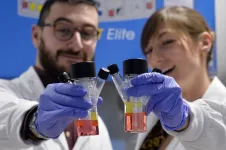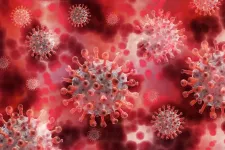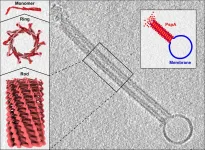(Press-News.org) GRAND RAPIDS, Mich. (June 24, 2021) -- The same taste-sensing molecule that helps you enjoy a meal from your favorite restaurant may one day lead to improved ways to treat diabetes and other metabolic and immune diseases.
TRPM5 is a specialized protein that is concentrated in the taste buds, where it helps relay messages to and from cells. It has long been of interest to researchers due to its roles in taste perception and blood sugar regulation.
Now, a team led by scientists at Van Andel Institute has published the first-ever high-resolution images of TRPM5, which reveal two areas that may serve as targets for new medications. The structures also may aid in the development of low-calorie alternative sweeteners that mimic sugar. The findings were published today in Nature Structural and Molecular Biology.
"TRPM5 is the cornerstone of taste signaling, which itself has a much larger role in the body than often recognized," said Wei Lü, Ph.D., an associate professor at VAI and co-corresponding author of the study. "We hope our structures of TRPM5 will serve as blueprints for designing new medications that help control blood sugar in diabetes, while also providing a template for development of low-calorie sweeteners that activate sensory circuits in the brain and the gut -- a key distinction that mimics sugar."
There are five types of taste that the body senses: sweet, sour, salty, bitter and umami. When the tongue encounters a taste, specialized cells on the tongue called taste receptors send messages about that taste to the brain. TRPM5 is a key part of the complex process that ushers these important signals on their way to the brain's sensory processing center.
But taste perception goes far beyond helping us sense the subtle flavors of a tiramisu. It helps protect the body by detecting bitter and acidic tastes, which commonly are associated with harmful substances. Taste perception also occurs beyond the tongue; for example, the process of taste perception in certain pancreatic cells regulates insulin secretion, which keeps blood sugar levels in check. Similar cells, called tuft cells, also coat the linings of the intestine, lungs and gallbladder, where they use TRPM5 and related proteins to sense the sugar-like byproducts of parasitic infections and trigger immune responses to deal with the threat.
"Targeting TRPM5 and taste-signaling throughout the body has two major potential benefits: it may help us improve treatment for a number of metabolic and immune disorders while also providing a path toward improved sweeteners," said Juan Du, Ph.D., an associate professor at VAI and co-corresponding author of the study. "While the body needs sugar to survive, too much of it can be harmful. We're hopeful a more thorough understanding of TRPM5 will lead to better alternatives."
TRPM5 belongs to the TRP superfamily, a group of proteins that mediate responses to sensory stimuli, such as pain, pressure, vision, temperature and taste. Broadly known as ion channels, proteins like TRP nestle within cells' membranes, acting as gatekeepers for chemical signals passing into and out of the cell. The eight proteins that comprise the TRPM subfamily are part of this broader group.
To date, Lü and Du laboratories have solved the structures of three of the eight known TRPM proteins as well as an ion channel called CALHM2, which belongs to the calcium homeostasis modulator family. Another member of this molecular family is CALHM1, also an important component of taste signaling.
INFORMATION:
Postdoctoral fellow Zheng Ruan, Ph.D., Van Andel Institute Graduate School Ph.D. candidate Emery Haley and Senior Research Scientist Ian J. Orozco, Ph.D., are co-first authors of the study. Other authors include Mark Sabat, Ph.D., and Richard Myers, Ph.D., of Takeda California, Inc., and Rebecca Roth of VAI. The structures were resolved in collaboration with the David Van Andel Advanced Cryo-Electron Suite at VAI.
Research reported in this publication was supported by Van Andel Institute; the National Heart, Lung, and Blood Institute of the National Institutes of Health under award no. R56HL144929 (Lü) and R01HL153219 (Lü); a McKnight Scholar Award (Du); a Klingenstein-Simons Scholar Award (Du); a Sloan Research Fellowship in neuroscience (Du); and a Pew Scholars in Biomedical Research Award from the Pew Charitable Trusts (Du). The content is solely the responsibility of the authors and does not necessarily represent the official views of the National Institutes of Health or other granting organizations.
Lü also is supported by the National Institute of Neurological Disorders and Stroke of the National Institutes of Health under award no. R01NS112363 and by the National Institute of General Medical Sciences of the National Institutes of Health under award no. R35GM138321. Du also is supported by the National Institute of Neurological Disorders and Stroke of the National Institutes of Health under grant no. R01NS111031. Ruan is supported by an American Heart Association postdoctoral fellowship under award no. 20POST35120556.
ABOUT VAN ANDEL INSTITUTE
Van Andel Institute (VAI) is committed to improving the health and enhancing the lives of current and future generations through cutting edge biomedical research and innovative educational offerings. Established in Grand Rapids, Michigan, in 1996 by the Van Andel family, VAI is now home to more than 400 scientists, educators and support staff, who work with a growing number of national and international collaborators to foster discovery. The Institute's scientists study the origins of cancer, Parkinson's and other diseases and translate their findings into breakthrough prevention and treatment strategies. Our educators develop inquiry-based approaches for K-12 education to help students and teachers prepare the next generation of problem-solvers, while our Graduate School offers a rigorous, research-intensive Ph.D. program in molecular and cellular biology. Learn more at vai.org.
BELLINGHAM, Washington, USA - The open access Journal of Astronomical Telescopes, Instruments, and Systems (JATIS) has published END ...
The study was conducted by an international collaboration involving the research team led by Luca Tiberi of the Armenise-Harvard Laboratory of Brain Cancer at the Department of Cellular, computational and integrative biology - Cibio of UniTrento, the Paris Brain Institute-Institut du Cerveau at Sorbonne Université in Paris, the Hopp Children´s Cancer Center (KiTZ) in Heidelberg, Germany, and Sapienza University in Rome. It was supported by Fondazione Armenise-Harvard, Fondazione Airc (Italian Association for Cancer Research) and Fondazione Caritro from Trento. The findings of the study, published in Science Advances, could lead to better and more effective treatments.
The team of researchers is proud of the results achieved. Luca Tiberi, coordinator of the study and corresponding ...
Dmitry Blinov is a co-author of the article and Senior Research Associate in the Department of Astrophysics, St Petersburg University. He notes that researchers have been studying the optical polarisation from active galactic nuclei for more than 50 years. Some of the first academic papers on this topic were published back in the 1960s by Vladimir Hagen-Thorn, Professor in the Department of Astrophysics, St Petersburg University, and Viktor Dombrovskiy, Associate Professor in the Department of Astrophysics, Leningrad State University.
In the Universe, the main material is concentrated in galaxies with hundreds of billions of stars: there are about 200-400 of them in the Milky Way. At the centre of galaxies there are supermassive ...
An international team of researchers co-led by the University of Adelaide and the University of Arizona has analysed the genomes of more than 2,500 modern humans from 26 worldwide populations, to better understand how humans have adapted to historical coronavirus outbreaks.
In a paper published in Current Biology, the researchers used cutting-edge computational methods to uncover genetic traces of adaptation to coronaviruses, the family of viruses responsible for three major outbreaks in the last 20 years, including the ongoing pandemic.
"Modern human genomes contain evolutionary ...
Rheumatologists are familiar with the everyday use of immunomodulatory drugs. These are designed to treat the inflammation caused by autoimmune diseases such as rheumatoid arthritis. A EULAR taskforce was set up to develop a set of new points to consider to give guidance and advice on the best way to use these medicines to treat COVID-19. The taskforce included rheumatologists, immunologists, haematologists, paediatricians, patients and other health professionals. They looked at the published evidence on the use of immunomodulatory therapies to treat severe COVID-19.
In total, there are two overarching principles and 14 points to consider. The principles stress that the picture of SARS-CoV-2 infection can be very different in different people. Infections range from asymptomatic ...
Measuring ethane in the atmosphere shows that the amounts of methane going into the atmosphere from oil and gas wells and contributing to greenhouse warming is higher than suggested by the U.S. Environmental Protection Agency, according to an international team of scientists who spent three years flying over three areas of the U.S. during all four seasons.
"Ethane is a gas that is related only to certain sources of methane," said Zachary R. Barkley, researcher in meteorology and atmospheric science, Penn State. "Methane, however, is produced by oil, ...
Understanding work participation is important, but the way in which this is defined and measured in clinical trials is not always the same, which has made it hard to compare data. EULAR set up a taskforce to draft points to consider when designing studies that use work participation as a measure. The taskforce included doctors, experts and patients from 11 countries. They used the published evidence to draw up a set of points to consider.
Two overarching principles and nine points to consider were developed. The principles say that work participation is important for people with inflammatory arthritis, their ...
Paper Title: Analysis of Common Shoulder Injuries in Collegiate Baseball Players
Journal: The Physician and Sportsmedicine (June 23, 2021, online edition)
Authors: Alexis Chiang Colvin, MD, Professor, Department of Orthopedic Surgery at the Icahn School of Medicine at Mount Sinai; Daniel A. Charen, MD, Resident, Department of Orthopedic Surgery at the Icahn School of Medicine at Mount Sinai; and other coauthors.
Bottom Line: Baseball players are highly susceptible to shoulder injuries due to significant microtrauma including repetitive overhead throwing. Mount Sinai researchers investigated men's National Collegiate ...
Fibromyalgia is one of many chronic pain conditions that remains stubbornly difficult to treat.
As the ravages of the opioid epidemic lead many to avoid these powerful painkillers, a significant number of people with fibromyalgia are finding an effective replacement in CBD-containing products, finds a new Michigan Medicine study.
CBD, short for cannabidiol, is the second most common cannabinoid in the cannabis plant, and has been marketed for everything from mood stabilization to pain relief, without the intoxicating effects produced by the most common cannabinoid, THC. THC, which stands for ...
The cells of simple organisms, such as bacteria, as well as human cells are surrounded by a membrane, which fulfills various tasks including protecting the cell from stress. In a joint project, teams from Johannes Gutenberg University Mainz (JGU) and Forschungszentrum Jülich, with participation of Heinrich Heine University Düsseldorf (HHU), have now discovered that a membrane protein found in bacteria has a similar structure and function as a group of proteins that are responsible for remodeling and rebuilding the cell membrane in humans. No connection between the two protein groups was known before. The team's research work has been published recently in the renowned journal Cell.
PspA plays a key role in bacterial stress response
The phage shock protein ...




